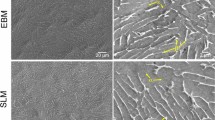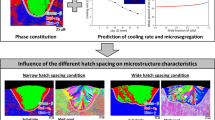Abstract
The ductility of as-fabricated Ti–6Al–4V falls far short of the requirements for biomedical titanium alloy implants and the heat treatment remains the only applicable option for improvement of their mechanical properties. In the present study, the decomposition of as-fabricated martensite was investigated to provide a general understanding on the kinetics of its phase transformation. The decomposition of asfabricated martensite was found to be slower than that of water-quenched martensite. It indicates that specific heat treatment strategy is needed to be explored for as-fabricated Ti–6Al–4V. Three strategies of heat treatment were proposed based on different phase transformation mechanisms and classified as subtransus treatment, supersolvus treatment and mixed treatment. These specific heat treatments were conducted on selective laser melted samples to investigate the evolutions of microstructure and mechanical properties. The subtransus treatment leaded to a basket-weave structure without changing the morphology of columnar prior β grains. The supersolvus treatment resulted in a lamellar structure and equiaxed β grains. The mixed treatment yielded a microstructure that combines both features of the subtransus treatment and supersolvus treatment. The subtransus treatment is found to be the best choice among these three strategies for as-fabricated Ti–6Al–4V to be used as biomedical implants.
Similar content being viewed by others
References
Niinomi M. Recent metallic materials for biomedical applications. Metallurgical and Materials Transactions A: Physical Metallurgy and Materials Science, 2002, 33(3): 477–486
Yang X, Richard Liu C. Machining titanium and its alloys. Machining Science and Technology, 1999, 3: 107–139
Murr L E, Quinones S A, Gaytan S M, et al. Microstructure and mechanical behavior of Ti–6Al–4V produced by rapid-layer manufacturing, for biomedical applications. Journal of the Mechanical Behavior of Biomedical Materials, 2009, 2(1): 20–32
Vandenbroucke B, Kruth J P. Selective laser melting of biocompatible metals for rapid manufacturing of medical parts. Rapid Prototyping Journal, 2007, 13(4): 196–203
Thijs L, Verhaeghe F, Craeghs T, et al. A study of the microstructural evolution during selective laser melting of Ti–6Al–4V. Acta Materialia, 2010, 58(9): 3303–3312
Kruth J P, Badrossamay M, Yasa E, et al. Part and material properties in selective laser melting of metals. Proceedings of the 16th International Symposium on Electromachining, 2010
Hollander D A, von Walter M, Wirtz T, et al. Structural, mechanical and in vitro characterization of individually structured Ti–6Al–4V produced by direct laser forming. Biomaterials, 2006, 27(7): 955–963
Rafi H K, Karthik N V, Gong H, et al. Microstructures and mechanical properties of Ti6Al4V parts fabricated by selective laser melting and electron beam melting. Journal of Materials Engineering and Performance, 2013, 22: 1–12
ASTMF1472-08e1. Standard specification for wrought titanium-6aluminum-4vanadium alloy for surgical implant applications (UNS R56400), 2008
ASTMF1108-04. Standard specification for titanium-6aluminum-4vanadium alloy castings for surgical implants (UNS R56406), 2009
Semiatin S L, Knisley S L, Fagin P N, et al. Microstructure evolution during a-ß heat treatment of Ti–6Al–4V. Metallurgical and Materials Transactions A: Physical Metallurgy and Materials Science, 2003, 34(10): 2377–2386
Vrancken B, Thijs L, Kruth J P, et al. Heat treatment of Ti6Al4V produced by selective laser melting: microstructure and mechanical properties. Journal of Alloys and Compounds, 2012, 541: 177–185
Vilaro T, Colin C, Bartout J D. As-fabricated and heat-treated microstructures of the Ti–6Al–4V alloy processed by selective laser melting. Metallurgical and materials Transactions A: Physical Metallurgy and Materials Science, 2011, 42(10): 3190–3199
ASTME8/E8M-13a. Standard test methods for tension testing of metallic materials, 2013
Mur F X G, Rodriguez D, Planell J A. Influence of tempering temperature and time on the a'-Ti–6Al–4V martensite. Journal of Alloys and Compounds, 1996, 234(2): 287–289
Qazi J I, Senkov O N, Rahim J, et al. Kinetics of martensite decomposition in Ti–6Al–4V–xH alloys. Materials Science and Engineering A, 2003, 359: 137–149
Aeby-Gautier E, Settefrati A, Bruneseaux F, et al. Isothermal a'' formation in ß metastable titanium alloys. Journal of Alloys and Compounds, 2013, 577: S439–S443
Wang S C, Aindow M, Starink M J. Effect of self-accommodation on a/a boundary populations in pure titanium. Acta Materialia, 2003, 51(9): 2485–2503
Lin H C,Wu S K, Chou T S, et al. The effects of cold rolling on the martensitic transformation of an equiatomic TiNi alloy. Acta Metallurgica et Materialia, 1991, 39(9): 2069–2080
Segui C, Cesari E, Font J, et al. Martensite stabilization in a high temperature Ni–Mn–Ga alloy. Scripta Materialia, 2005, 53(3): 315–318
Brandl E, Greitemeier D. Microstructure of additive layer manufactured Ti–6Al–4V after exceptional post heat treatments. Materials Letters, 2012, 81: 84–87
Lee Y T, Welsch G. Young’s modulus and damping of Ti–6Al–4V alloy as a function of heat treatment and oxygen concentration. Materials Science and Engineering A, 1990, 128(1): 77–89
Wegmann G, Albrecht J, Lütjering G, et al. Microstructure and mechanical properties of titanium castings. Zeitschrift fur Metallkunde, 1997, 88: 764–773
Al-Bermani S, Blackmore M, Zhang W, et al. The origin of microstructural diversity, texture, and mechanical properties in electron beam melted Ti–6Al–4V. Metallurgical and Materials Transactions A: Physical Metallurgy and Materials Science, 2010, 41(13): 3422–3434
Lu Y, Tang H, Fang Y, et al. Microstructure evolution of subcritical annealed laser deposited Ti–6Al–4V alloy. Materials & Design, 2012, 37: 56–63
Lütjering G, Williams J. Titanium. 2nd ed. Berlin: Springer, 2003
Zhao Y, Qu H, Wang M, et al. Thermal stability and creep behavior of Ti–V–Cr burn-resistant alloys. Journal of Alloys and Compounds, 2006, 407(1–2): 118–124
Author information
Authors and Affiliations
Corresponding author
Rights and permissions
About this article
Cite this article
Huang, Q., Liu, X., Yang, X. et al. Specific heat treatment of selective laser melted Ti–6Al–4V for biomedical applications. Front. Mater. Sci. 9, 373–381 (2015). https://doi.org/10.1007/s11706-015-0315-7
Received:
Accepted:
Published:
Issue Date:
DOI: https://doi.org/10.1007/s11706-015-0315-7




